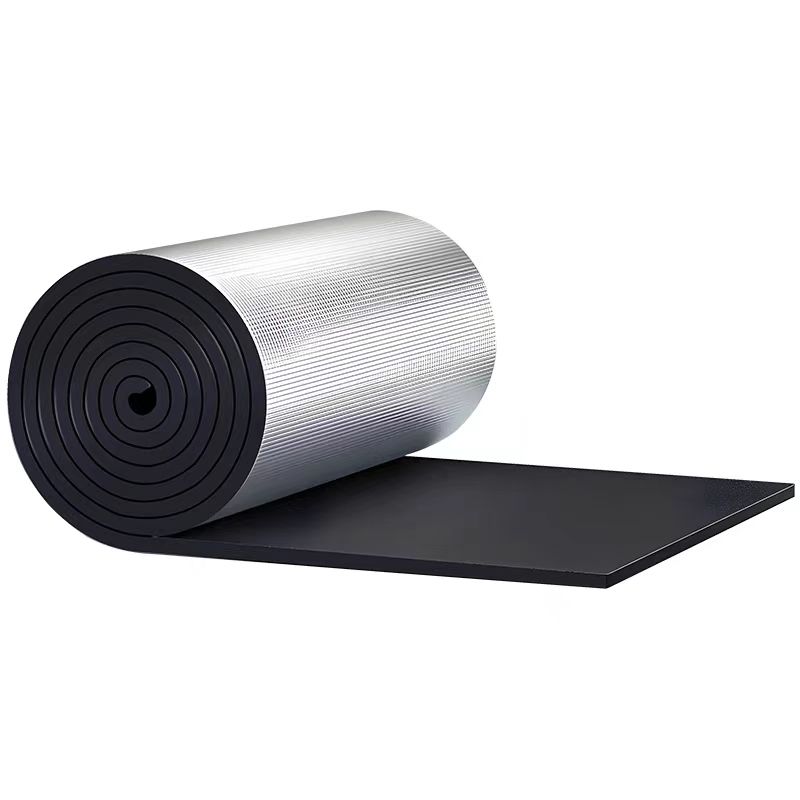


04 2025
1 insulation material status
From a heat transfer perspective, cold insulation and heat preservation have the same meaning, both of which are to reduce heat transfer. The only difference is the direction of heat transfer. Since obtaining cold energy requires more energy than obtaining the same amount of heat, and the lower the boiling point of the medium, the greater the energy consumption. Therefore, in cold insulation engineering, cold insulation technology is particularly important. At present, there are generally problems in the cold insulation design of wellbore freezing stations, such as thin cold insulation layers, and the moisture-proof, vapor barrier and protective layers in the cold insulation structure are mostly incomplete, or even without setting up vapor barrier and protective layers, resulting in a large amount of cold loss. Due to the large investment and high energy consumption of the freezing station refrigeration system, it is necessary to improve the understanding of the cold insulation and adiabatic engineering of the low-temperature brine pipeline of the freezing station ammonia refrigeration system, carefully organize construction, and strengthen management to prevent or reduce cold loss and save electric energy.
2.Selection of cold insulation materials for
In order to achieve the purpose of cold insulation, suitable cold insulation materials must be selected. There are two important technical indicators for the selection of cold insulation materials: First, the thermal conductivity coefficient. Since the thermal conductivity coefficient is proportional to the heat loss of the pipeline, when there are multiple cold insulation materials to choose from, the smaller the product of the thermal conductivity coefficient and its unit volume price, the more economical it is; second, the density. Generally, the smaller the density of the material, the smaller its thermal conductivity coefficient.
In addition, the mechanical strength, applicable temperature, flame retardancy, etc. of materials are also factors that need to be considered when correctly selecting cold insulation materials. Commonly used cold insulation materials mainly include polystyrene foam plastic, phenolic foam plastic, polyvinyl chloride foam plastic, rigid polyurethane foam plastic, rubber-plastic sponge, etc. At present, the main cold insulation material used in well shaft freezing stations is rubber-plastic sponge cold insulation material. It is a new type of cold insulation material that has emerged in recent years. It has a sealed bubble structure and is vapor-proof.
Add a vapor barrier; low water absorption, small thermal conductivity, good flame retardant effect, excellent stretching and bending characteristics, can withstand tearing and rough force transmission, and will not be damaged even in severe situations. It is an efficient, economical and durable composite material. Since rubber-plastic sponge cold insulation material does not need to set up a vapor barrier and protective layer, the installation is simple and fast. Rubber-plastic sponge cold insulation material technology.
Technical performance parameters are as follows:
Applicable temperature range一 50~ 150℃
density75~ 100kg/m。
moisture resistance factor≥ 4 500
thermal conductivity : -20。C 0.03lW/(m ·K)
0℃ 0.034W/(m ·K)
2O℃ 0.036W/(m ·K)
Tear strength 40kPa
ozone resistance 2OOh表 面未 出现 裂 纹
Combustibility: Flame-retardant B1 grade
3 insulation thickness calculation
According to GB/T8175—2008 “Guidelines for thermal insulation design of equipment and pipelines” and GB/T4272-2008 “General rules for thermal insulation technology of equipment and pipelines”, the basic principles for calculating the thickness of cold insulation layer are as follows:
(1) In order to reduce cold loss (heat absorption) and prevent condensation on the outer surface for cold insulation, the economic thickness method is used to calculate the thickness of the cold insulation layer, and the outer surface temperature is measured by the heat balance method. This temperature should be higher than the ambient dew point temperature.
(2) For cold insulation to prevent condensation on the outer surface, the thickness of the cold insulation layer is calculated by the surface temperature method.
For insulation where the cold loss is allowed in the process, the thickness of the insulation layer is calculated by the heat balance method, and its outer surface temperature is checked. This temperature should be higher than the dew point temperature of the environment.
For shaft freezing stations, the main purpose of thermal insulation is “no condensation”. At the same time, referring to the calculation method of insulation layer thickness for preventing condensation on the outer surface of chemical plants, it is determined to use the surface temperature method to calculate the insulation layer thickness. The calculation formula is as follows: X lnx – (1) – Dg~(X – 1).) (2)
In Equations (1) and (2): X—D/D0. The X value can be obtained by looking up a table. D is the outer diameter of the insulated pipeline, in meters. D0 is the outer diameter of the pipeline, in meters. λ is the thermal conductivity coefficient of the insulation material, in W/(m·K). α is the heat release coefficient on the outer surface of the insulation layer. Generally, it is taken as 8.14 W/(m·K). t is the surface temperature of the insulation layer. t = ta+(1–3)°C. ta is the dew point temperature, in °C. t1 is the outer surface temperature of the pipeline, in °C. t2 is the ambient air temperature, in °C. δ is the thickness of the insulation layer, in meters.
Taking the low-temperature brine pipeline of a freezing station in Jinan area as an example, calculate the thickness of the cold insulation material of rubber-plastic sponge. The dew point temperature t in this area is 29.4 °C. The surface temperature t of the cold insulation layer is taken as 31.4 °C. The external surface temperature of the pipeline (brine temperature) t is -36 °C. The surrounding air temperature t is 34.8 °C, and the relative humidity is 73.Plastic sponge Thermal conductivity is taken as 0.031 W/(m·K), and the external surface heat release coefficient a is taken as 8.14 W/(m·K). Substituting the above parameter values into equation (1), we get.
5 Conclusion
Cold preservation is more complex than heat preservation because obtaining cold energy requires more energy than obtaining the same amount of heat energy. In the design of a freezing station, in addition to selecting reliable cold insulation materials with reliable performance, the reasonable determination of the thickness of the cold insulation layer is also very important. The thickness of the cold insulation layer should be determined by calculation in combination with various relevant parameters under actual working conditions to ensure a cold insulation layer with sufficient thickness and avoid or reduce cold loss. Of course, the cold loss of a freezing station is not only caused by the too thin design of the cold insulation layer, but construction also has a certain relationship. In the construction of the cold insulation layer, no joints can be overlooked and must be tightly filled, and problems such as gaps that appear after expansion should also be considered.
We focus on the research and development as well as manufacturing
of thermal insulation materials and sealing materials.